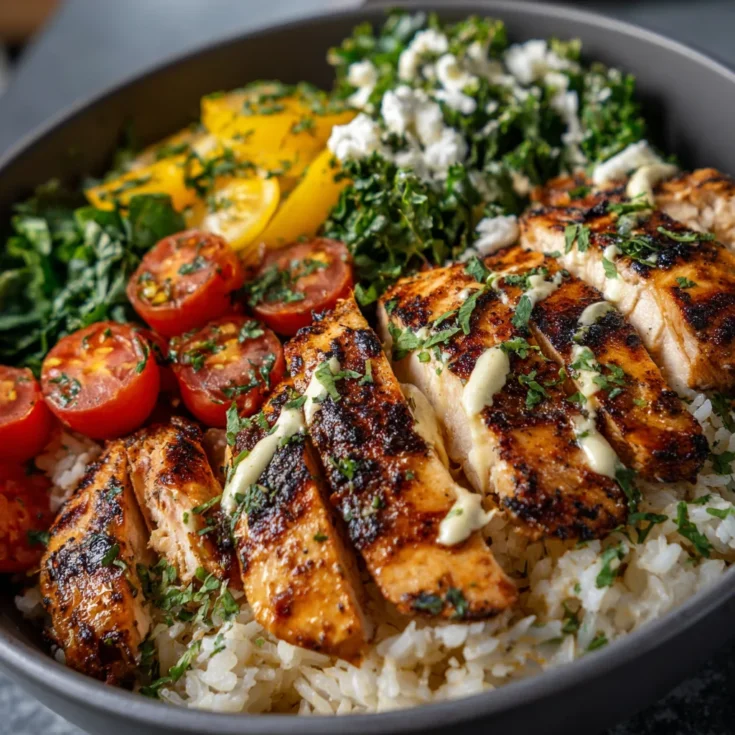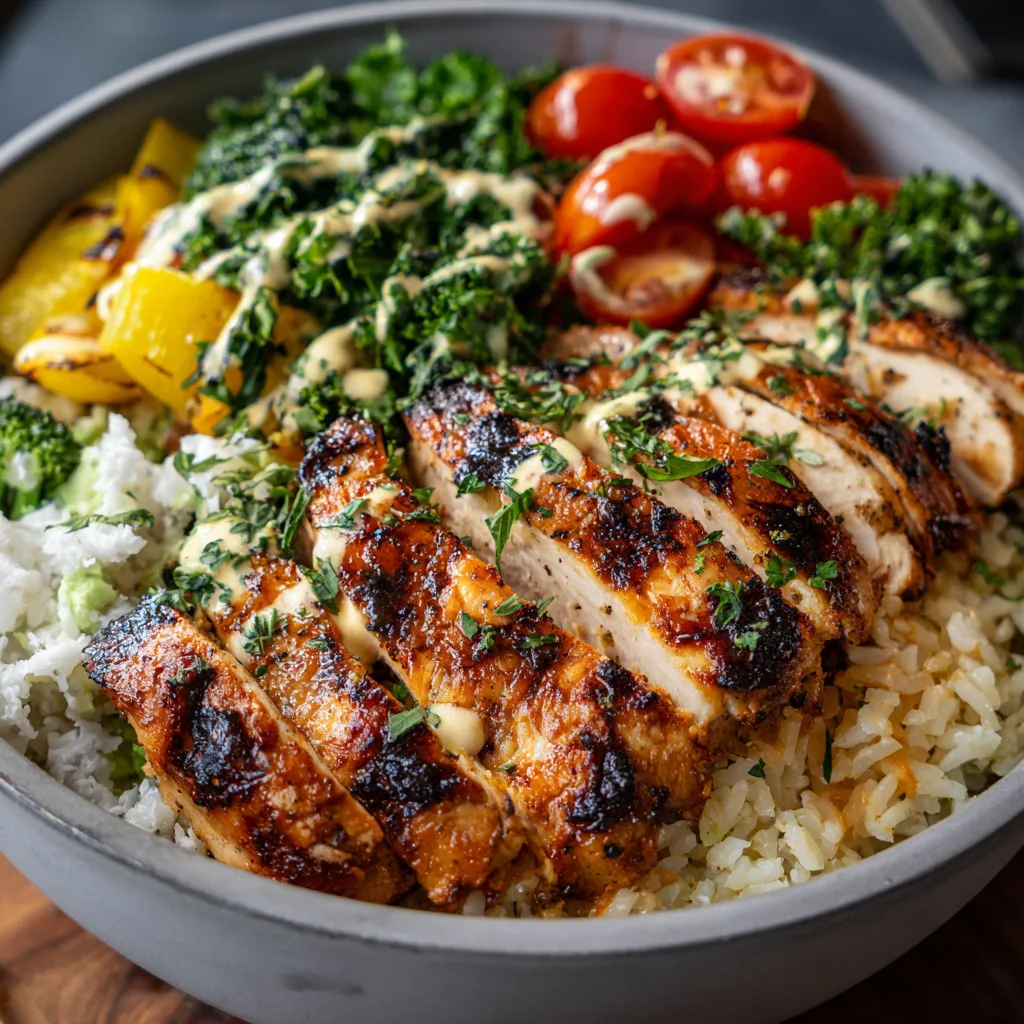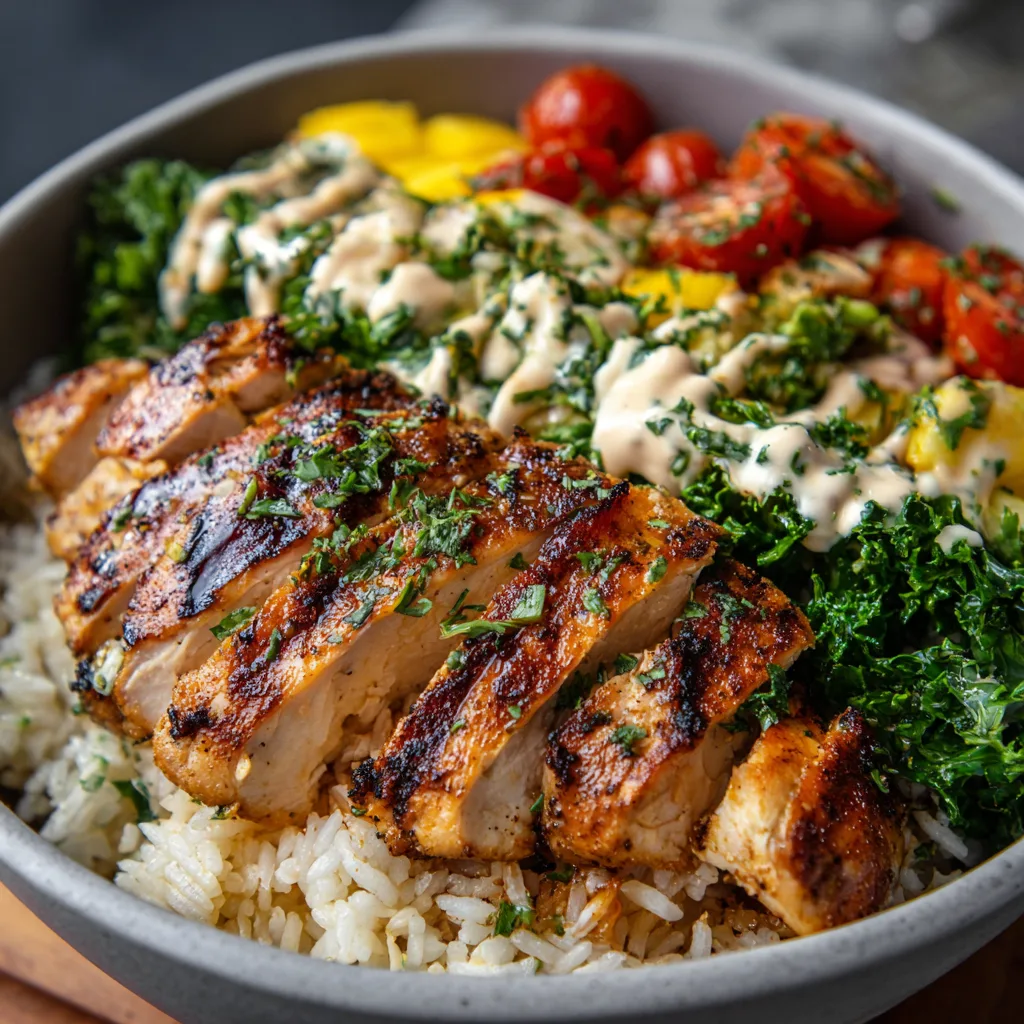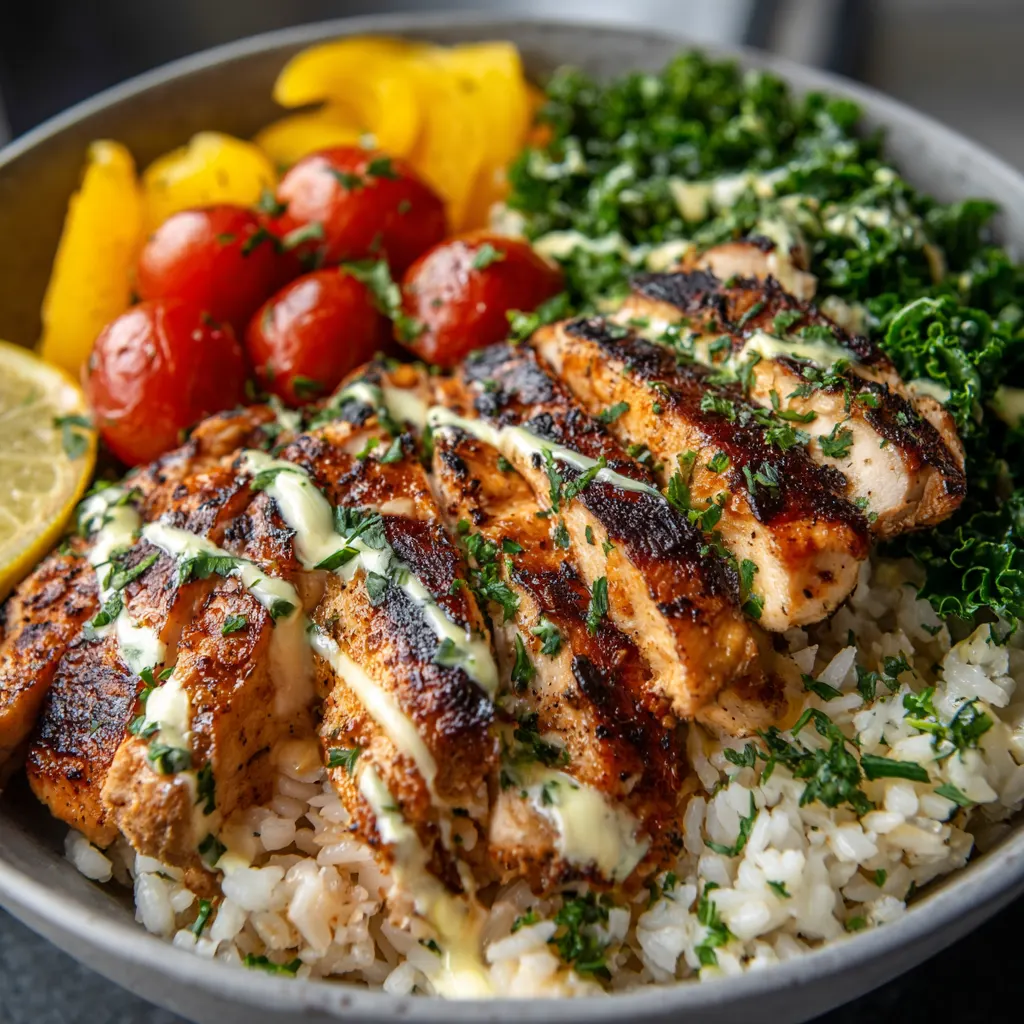Healthy Grilled Chicken Breast Rice Bowl – A Nutritious and Delicious Meal
Grilled chicken breast rice bowls have become a favorite for those seeking a wholesome, balanced meal. This dish combines lean protein with wholesome grains and fresh vegetables, making it both satisfying and nourishing. Its versatility allows people to customize flavors and ingredients to suit their tastes and dietary needs.
The popularity of grilled chicken rice bowls stems from their simplicity and health benefits. Chicken breast provides a rich source of lean protein without excess fat. Paired with nutrient-packed rice and vibrant veggies, the bowl offers a complete meal that fuels the body efficiently. Many find this option perfect for meal prepping or quick dinners that do not compromise on taste or nutrition.
Chicken breast is low in calories and high in essential nutrients like B vitamins and selenium. Meanwhile, rice serves as an excellent source of complex carbohydrates, providing sustained energy. Together, they support muscle repair, digestion, and overall well-being. When combined with fiber-rich vegetables and healthy fats, this bowl becomes a powerhouse of nutrition.
This dish suits a variety of dietary lifestyles. Whether you aim for weight management, high-protein intake, or clean eating, the grilled chicken breast rice bowl fits seamlessly. It offers balanced macronutrients with minimal processing and no added sugars or unhealthy fats. The customizable nature of the bowl allows it to adapt to gluten-free, dairy-free, or paleo diets as well.
In this article, we explore the benefits, preparation methods, and variations of healthy grilled chicken breast rice bowls. You’ll also find tips for cooking, assembling, and customizing this meal to make it your go-to nutritious choice. Let’s dive into why this bowl deserves a spot on your weekly menu.
Nutritional Profile of Grilled Chicken Breast: High-Protein Powerhouse for Muscle and Satiety
Grilled chicken breast stands out as an excellent source of lean protein, essential for muscle growth and repair. Each serving provides ample protein that helps you feel full longer, reducing overeating. Compared to fattier meats, chicken breast has significantly fewer calories and less saturated fat, making it ideal for those watching their weight or heart health.
Besides protein, chicken breast delivers important nutrients such as B vitamins, which support energy metabolism and brain function. It also contains phosphorus, vital for strong bones, and selenium, an antioxidant that protects cells from damage. This nutrient profile makes grilled chicken breast a smart choice for overall wellness.
Health Benefits of Rice as a Base: Choosing the Right Grain for Sustained Energy
Rice forms the foundation of many healthy bowls, but not all rice varieties offer the same nutrition. Common types include white, brown, jasmine, and basmati rice. Brown rice and other whole-grain varieties retain the bran and germ, offering more fiber, vitamins, and minerals than refined white rice.
Fiber in whole-grain rice slows digestion, providing a steady release of energy and helping maintain stable blood sugar levels. This makes brown rice a better option for sustained energy and digestive health. White rice, while quicker to cook and easier to digest, lacks fiber but can still serve as a light, palatable base.
Complementary Ingredients to Boost Nutrition: Vegetables, Healthy Fats, and Flavorful Enhancers
Adding a variety of colorful vegetables transforms a simple rice bowl into a nutrient-packed meal. Bell peppers, spinach, avocado, and broccoli provide antioxidants, vitamins, and minerals that support immune health and reduce inflammation. These veggies also add fiber, which promotes digestive wellness.
Healthy fats, such as those found in olive oil, avocado, and nuts or seeds, improve nutrient absorption and support heart health. Incorporating these fats balances the meal’s macros and enhances flavor.
Flavor enhancers like fresh herbs, spices, lemon juice, and garlic not only add zest but offer health benefits. Garlic supports immune function, while herbs provide antioxidants without adding calories or sodium.
Balancing protein, carbohydrates, and fats in your grilled chicken breast rice bowl creates a complete meal that fuels your body, satisfies hunger, and supports long-term health. This synergy between ingredients makes the dish both delicious and nourishing.
Selecting and Preparing the Chicken Breast: Choose Fresh, Flavorful Cuts
Start by selecting fresh, high-quality chicken breasts. Look for firm, pale pink meat without any off odors or discoloration. Organic or free-range options often offer better flavor and fewer additives. Choosing uniform-sized breasts ensures even cooking.
To enhance flavor and tenderness, marinate the chicken before grilling. A simple marinade combines olive oil, lemon juice, garlic, and herbs like rosemary or thyme. Keep the marinade low in sodium and avoid added sugars to maintain the dish’s health benefits. Let the chicken soak for at least 10 minutes, or up to overnight for deeper flavor and juiciness.
Grilling Techniques for Perfect Chicken Breast: Achieve Juicy, Evenly Cooked Meat
Grilling chicken breast requires attention to temperature and timing to avoid dryness. Preheat your grill to medium-high heat. Grill the chicken for about 6 to 8 minutes per side, turning only once to get nice grill marks and even cooking. Use a meat thermometer to ensure the internal temperature reaches 165°F (75°C).
To prevent drying out, avoid flipping too frequently and let the chicken rest for 5 minutes after cooking. This allows juices to redistribute for moist, tender meat. If you don’t have a grill, baking at 400°F for 20 minutes or pan-searing on medium-high heat until cooked through are great alternatives that preserve flavor and nutrition.
Cooking the Rice for Optimal Texture and Nutrition: Fluffy, Flavorful Grains Every Time
Choosing the right cooking method impacts rice texture and nutrition. Brown rice requires longer cooking—about 40-45 minutes—while white rice cooks faster, usually 15-20 minutes. You can cook rice on the stovetop, in a rice cooker, or Instant Pot depending on convenience.
For fluffy, non-sticky rice, rinse grains before cooking to remove excess starch. Use a 1:2 rice-to-water ratio for stovetop cooking and avoid stirring while cooking. To boost flavor without extra calories, cook rice in low-sodium vegetable broth or add herbs like bay leaves or thyme to the pot.
Assembling the Rice Bowl: Balance, Beauty, and Flavor in Every Bite
When assembling your rice bowl, layer ingredients thoughtfully. Start with a base of rice, then add grilled chicken slices. Arrange colorful vegetables such as steamed broccoli, diced bell peppers, and avocado slices on top for visual appeal and nutritional balance.
Choose healthy sauces and dressings like lemon-tahini, yogurt-based dressings, or a splash of low-sodium soy sauce to add moisture and flavor without excess calories. For meal prepping, store components separately in airtight containers. Combine just before eating to maintain freshness and texture, making this bowl an ideal, convenient meal option.
Rice Alternatives and Grain Options: Exploring Nutritious Substitutes
While rice serves as a classic base, several alternatives offer unique flavors and nutrition. Quinoa stands out as a protein-rich seed with a nutty taste and all nine essential amino acids. Cauliflower rice appeals to those seeking low-carb, fiber-rich options with minimal calories. Farro and bulgur provide chewy textures and a boost of fiber, minerals, and antioxidants. Each substitute shifts the dish’s carbohydrate profile, making it easier to tailor to personal health goals.
Swapping rice with these grains or vegetables changes the bowl’s flavor and texture. Quinoa adds earthiness, cauliflower rice offers a mild, fresh bite, while farro and bulgur bring a hearty chew. These swaps keep the meal exciting and nutritionally diverse.
Protein Variations: Lean Options Beyond Chicken Breast
Although grilled chicken breast remains popular, other lean proteins fit well in a rice bowl. Turkey breast provides a similar protein punch with a slightly different flavor profile. Tofu offers a plant-based protein alternative suitable for vegetarian and vegan diets. Shrimp brings a light, seafood twist with low calories and high protein.
Combining proteins can enhance texture and taste. For example, mixing grilled chicken with shrimp or adding crispy tofu cubes adds variety and complexity, keeping each bite interesting and satisfying.
Flavor Profiles from Different Cuisines: Global Inspirations for Your Rice Bowl
Bringing global flavors into your rice bowl adds excitement and variety. An Asian-inspired bowl might include soy sauce, fresh ginger, and toasted sesame oil, offering a savory, aromatic experience. Mediterranean flavors come alive with lemon juice, oregano, and olives, delivering brightness and herbal notes. For a Mexican twist, incorporate fresh cilantro, lime juice, and black beans to add zest and earthiness.
These international profiles allow easy customization while maintaining the dish’s health focus, letting you enjoy new tastes without guilt.
Dietary Adaptations: Modifying the Rice Bowl for Special Diets
This meal easily adapts to various dietary needs. For gluten-free options, stick to naturally gluten-free grains like brown rice or quinoa and avoid soy sauce unless labeled gluten-free. Dairy-free diets work well since the bowl rarely includes dairy, but be mindful of dressings.
Paleo and keto followers can replace rice with cauliflower rice or other low-carb veggies and choose healthy fats generously. Always select protein and vegetable options that fit your plan without compromising flavor or nutrition.
By adjusting ingredients thoughtfully, you keep the grilled chicken breast rice bowl versatile, satisfying, and perfectly aligned with your dietary goals.
Common Questions About Healthy Grilled Chicken Breast Rice Bowls
What is the healthiest rice to use in a rice bowl?
Whole grain options like brown rice or wild rice are the healthiest choices. They offer more fiber, vitamins, and minerals compared to white rice. These whole grains support digestion and provide steady energy.
How long can I store a grilled chicken rice bowl in the fridge?
You can safely store a grilled chicken rice bowl in the refrigerator for up to 3 to 4 days. Keep the components in airtight containers to maintain freshness and prevent contamination.
Can I freeze grilled chicken breast rice bowls?
Yes, freezing is possible but may affect texture, especially of vegetables. Store chicken and rice separately in freezer-safe containers. Thaw overnight in the fridge before reheating gently.
How can I keep the chicken moist when grilling?
Marinate the chicken with oil and acidic ingredients like lemon juice or vinegar before grilling. Avoid overcooking by monitoring internal temperature, aiming for 165°F (75°C). Let the chicken rest for a few minutes after grilling to retain juices.
Are rice bowls good for weight loss?
Yes, rice bowls with lean protein, whole grains, and vegetables provide balanced nutrition that supports weight loss. Controlling portion sizes and using healthy fats and sauces helps keep calorie intake in check.
What are good low-calorie sauces for rice bowls?
Opt for sauces like lemon juice, salsa, low-sodium soy sauce, tahini mixed with water, or yogurt-based dressings. These add flavor without excess calories or unhealthy fats.
Can I make this dish vegan or vegetarian?
Absolutely. Replace chicken breast with plant-based proteins like tofu, tempeh, or chickpeas. Use vegetable broth for cooking rice and add plenty of vegetables and healthy fats to keep the bowl balanced and satisfying.
Healthy Grilled Chicken Breast Rice Bowl – Nutritious & Flavorful Meal

This grilled chicken rice bowl delivers a balanced meal full of lean protein, wholesome grains, and fresh vegetables. It makes a perfect healthy choice for lunch or dinner that fuels your body with essential nutrients
Ingredients
- 2 large boneless, skinless chicken breasts
- 1 cup brown rice (uncooked)
- 1 tbsp olive oil
- 1 tsp smoked paprika
- 1 tsp garlic powder
- Salt and pepper to taste
- 1 cup steamed broccoli florets
- 1/2 cup diced bell peppers
- 1 avocado, sliced
- 1/4 cup chopped fresh cilantro
- Juice of 1 lime
- Optional: low-sodium soy sauce or tahini dressing
Instructions
Notes




